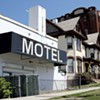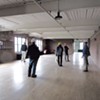Published August 19, 1993 at 4:00 a.m.
Bob Dylan performed there. So did Bob Marley, B.B. King, Bonnie Raitt, Frank Zappa, k.d. lang, Public Enemy. And Leontyne Price, Yo Yo Ma, the Kracow Philharmonic, Philip Glass. Whatever else might be said about Burlington's Memorial Auditorium, hordes of us have experienced some of our finest concerts there.
And that's not to mention the 20-odd Champlain College basketball games per year, the annual Vermont Golden Gloves Tournament, craft shows, psychic fairs, umpteen nonprofit events or, well, the Chippendales. Memorial has hosted political panjandrums, too: Geraldine Ferraro, Jerry Brown, Jesse Jackson, Al Gore and our own Bernie Sanders.
Over the past decade, hundreds of tots have played and napped at the Burlington Children's Space in Memorial's basement, while the pubescent set has slam-danced evenings away at 242 Main, a.k.a. the Teen Center. Meanwhile, the third-floor "loft" has provided cheap rehearsal space to dozens of local dancers and other performers.
It would seem that the hulking edifice on South Union Street — built in 1927 and dedicated to the memory of World War I's fallen — is a vital, if imperfect, star in the modest constellation of Burlington's public spaces. But some say the Classical Revival-style building has become an expensive albatross around the city's neck. Some concert promoters are shunning it, and certain state officials have wanted to shut it down.
The problem is this: Memorial Auditorium, like a dear but elderly aunt, has simply not kept up. A consultant for the city called it "the most dangerous building" he'd ever visited.
In many respects, Memorial has suffered from what can charitably be called benign neglect. There's been some general dilapidation, of course. But time's passage has also brought more stringent fire, safety and accessibility regulations that have reduced the building's capacity by 28 percent. And in order to compete with venues such as the Flynn Theatre, Memorial needs better equipment and more aggressive management.
Now the city — under the aegis of Burlington City Arts — is scheming ways to redress years of inattention. Following a state safety inspection of the auditorium that cited 26 code violations, the city doesn't have any choice. Unfortunately, it also doesn't have the estimated $1 million-plus needed to bring old Aunty Memorial up to date.
Michael Metz became the new director of City Arts the day Republican Peter Brownell defeated Progressive Peter Clavelle and ushered out 12 years of arts-friendly rule in city hall. Soon after, it looked like Metz might have a short appointment; Brownell almost axed the arts budget. But after some finagling — and public protest — a deal was struck that salvaged the arts office. As a part of that deal, Metz was handed the reins of Memorial Auditorium, which he has grasped with characteristic optimism.
The decision brought to a close Union Street Management's nine-year tenure at Memorial. One of Union’s partners, Alan Abair, has been retained as interim consultant while Metz searches for a permanent manager. Abair himself is a candidate for the position, which is expected to be filled this week. [Editor's Note: As Vermont Times was going to press, City Arts announced the appointment of David Archer as the new manager of Memorial Auditorium. A marketing and facilities consultant, Archer moved to Vermont from Boston in 1989.]
If Metz is the new, eager champion for Memorial's possibilities, Abair has been the caretaker of its memories, evidenced by the numerous concert posters lining the walls of his office. "It's not realized how much this building is used," he says. “Seven hundred events a year are booked in Memorial."
Long before he was hired to manage it, Abair attended basketball games and shows at the auditorium while growing up in Burlington. He regards Memorial with the affection of a parent for his child and gently deflects any criticism of it. Don’t like the booming acoustics at rock concerts? He’ll tell you about loads of orchestras, or lower-volume acts like Mel Tormé, who thought the sound was just dandy. Think parking is a hassle? Abair likes to tell about the time Kenny Rogers sold out two shows. "We had 2,500 people inside at the first show, and 2,500 waiting outside for the second show," he recalls. "All of them found parking.”
Despite Abair's devotion, Metz says the management of Memorial "was flawed in the past" and cites examples that generally have to do with a lack of efficiency: one of two full-time custodians reported to Abair, the other to city hall; the now- defunct Youth Office handled the Teen Center; the daycare is independently managed and the loft is essentially governed and scheduled by a consortium of its users. Union handled the scheduling of the auditorium and the basement and oversaw all events, including concessions. When Union's contract with the city lapsed three years ago, no one bothered to renew it.
But centralizing control of Memorial is a breeze compared to the other tasks Metz is charged with: bringing the building up to code and — perhaps nearly as difficult — improving its public image.
The physical problems may be the most daunting. In 1991, the state conducted an overdue fire inspection. Some of the 26 code notations were minor, such as inspecting fire extinguishers and installing “No Smoking" signs. Other necessities, however, are big-ticket items, such as sprinklers, fire doors with specific hardware, a new fire alarm system, and a proscenium curtain that "resists the passage of hot gases, smoke and fire for at least five minutes."
In response to the violations, City Treasurer Brendan Keleher presented an "action plan" for attending to Memorial's safety requirements. It included installing a sprinkler system within two years and a complete fire alarm system, as well as stair towers and related doors and hardware, within five years. (The Burlington City Council this year passed an amendment to the fire alarm ordinance requiring certain city-owned buildings, including Memorial, to switch over to a new radio call-box system. The deadline for compliance is April 1994.)
“The city begged the state to give it time to come up with a plan," recalls Susan Green, director of City Arts from late 1985 until early this year. "The compromise was to not fill Memorial to its 2,500-seat capacity and not allow dancing."
Green refers to two other reports that included evaluations of Memorial. The first was a 1990 Community Cultural Needs Assessment, sponsored by City Arts, which involved sending out over 7,000 questionnaires and conducting interviews with local citizenry. Two goals were to inventory existing arts facilities and to assess public perception of them. Green remembers that a typical response toward Memorial was "either fix it or burn it down."
Feeling that a more detailed study of arts facilities was necessary, City Arts last year hired two noted cultural-space consultants, Joseph Golden and Robert Brannigan. "I was stunned," Green says, "when Joe Golden told me Memorial Auditorium was the most dangerous building he'd ever been in, period."
Less than a month later, a section of bleachers collapsed during a Samples concert. All Points Booking had promoted the show as a dance concert, but the auditorium was outfitted with seats on the floor, and the new rules prohibited dancing. Undeterred, a number of concert-goers left their seats and gyrated illegally on the bleachers, later finding themselves in a heap. As Alan Abair is quick to protest, the bleachers did not exactly collapse, nor were they cited as dangerous in any report. Bleachers are not made for dancing, and they simply began to fold up under the pressure. However, the incident fueled doubts about the auditorium's general safety. Luckily, no one was seriously injured, and the whole thing blew over.
No dire pronouncements about Memorial appear in Golden and Brannigan's report, issued in May 1992. Instead, they settle for this description: "Forbidding and sullen in external appearance, architecturally undistinguished, dreary and deteriorating internally, the three-story Memorial nonetheless serves a critical and useful purpose. It is, basically, a large basketball court with a seriously deficient stage at one end. It is heavily programmed, obliging users to overcome a number of serious handicaps in order to make their events work."
The report acknowledges that the City of Burlington was preparing to address the violations cited by the fire marshal. Oriented to the performing arts, Golden and Brannigan recommend seven additional safety and technical items that refer mostly to the stage area. These include installing a permanent catwalk access to stage lighting fixtures, replacing the draperies and providing a new 60-foot track for rear stage curtains, and providing a "Genie" tower manlift for production and general maintenance use — all for an estimated $59,000.
The report also recommends improvements in stage loading. It says nothing about the loading area outside the auditorium, which APB's Jay Strausser says is one of the "worst load-ins ever — people hate it."
The report also doesn’t mention handicap access. But on the phone from his home in Connecticut, Robert Brannigan remarks that there is a ramp for entering Memorial but none for the stage. “This is a primary concern today for performing arts promoters," he says, adding that “Itzhak Perlman is a leading spokesperson" about access for the handicapped.
So how did violinist Perlman, who walks with crutches and cannot bend his legs, get onstage when he performed — twice — at Memorial? Former Lane Series Director Terry Demas, now living in Nashville, remembers well. When Perlman first came in the early '80s, Memorial had no ramp at all. "Mr. Perlman is a charming man but not shy regarding matters of treatment of the physically challenged," Demas says. "His comments were used as part of a Lane Series case study recommending handicap access." So when Perlman returned to Memorial in the mid-‘80s, he used the new ramp in front but still had to negotiate — with great difficulty — the stairs to the stage. The Lane Series, which used to hold about half their events at Memorial Auditorium, hasn't booked the facility since 1991.
All these problems, and the roof leaks, too.
Memorial’s reputation may be tarnished, but Michael Metz believes that addressing the building's physical needs will help ameliorate that. This summer, a full-time crew is replacing broken windows, renovating seats, refinishing the floor, and doing general cleaning, repairing, painting and landscaping. Though invisible to the public, important reorganization is taking place internally, and several unused offices are being readied for renting. Capital expenditures of $85,000 were approved by the Board of Finance, which will go toward fixing the roof, installing the sprinkler system and, the new fire alarm box. But even these significant safety and cosmetic measures may not be enough to please the critics.
Promoters, particularly, have multiple gripes. "We've done nothing but lose money [at Memorial] over the course of the last year or two" says Jay Strausser. “I have major concerns with what they're doing with the capacity." The auditorium's current maximum of 1,800 prohibits promoters from booking some acts, as they simply can't pay for themselves. In addition, Strausser claims, "the shows that really work are ones with no seats, where the people can dance and have fun." He believes a chairless floor is safer, but the fire marshal disagrees.
Both Strausser and his colleague Keith Beccia at Metropolitan Entertainment in New Jersey, who have co-promoted numerous shows in Vermont, say about Memorial that “people don't want to go there, and people don't want to play there." Beccia says that he could bring a wider variety of entertainment — such as Robert Plant, Nirvana or Dolly Parton — to Burlington if a larger, more professional venue were available. People like to go to the Flynn, he says, but it can't accommodate bigger acts. He, like Strausser and other local promoters, are intrigued by rumors over at Champlain Fairgrounds about building a multi-use facility with up to 8,000 seats — but they're not holding their breath.
Despite past losses, Strausser expects to continue doing "some business" with Memorial. But that business will be more lucrative for both when a full house means a capacity of 2,500.
If promoters have lost a few shirts on shows at Memorial, it's nothing compared to what the city itself has lost in potential revenues there every year. Both Green and Metz claim that Union street management was not sufficiently "proactive" in booking events at the auditorium. Whether or not that's true, Abair points out that the primary user of Memorial over the years has been the city of Burlington. Bookings by various city departments account for more than 63 percent of activities held there each year, he says, and the majority pay no rent.
The Burlington Children's Space pays no rent, either; its 3,200 square feet were an in-kind donation by the city. Abair claims that losing that space cost Memorial the annual four-day Vermont Hand Crafters show, which, after 40 years in the auditorium, moved to the more capacious Sheraton Burlington Hotel.
Even those who do pay for space at Memorial have gotten away easy — at $1,000 per day ($750 for nonprofits) upstairs and $500 ($400 nonprofit) in the basement. Metz says the rents will be raised this year but will still be competitive with other facilities. The arrangement with Champlain College — for games, practices, commencement and parties —will continue as usual. Furthermore, City Arts will be handling concessions and taking 50 percent of the revenues.
In addition to hiring a manager, Metz will be working with a newly organized Memorial Auditorium Committee whose responsibilities include developing a long-term agenda for the facility and fundraising for capital improvements. It is also planning yet another assessment of what role the community would like Memorial to fill. It could more easily take a look at assessments already done by the arts office or by Brannigan and Golden. The latter express disappointment, meanwhile, that "from the time we turned in that report, we haven't heard from anyone" in Burlington.
For all the critics of Aunty Memorial, she also has a lot of defenders besides Abair and Metz. One is architect John Anderson, who's been invited to serve on the committee. His summation of Memorial Auditorium is a great deal kinder than a fire marshal's terse report or a consultant's disapprobation. It's "a kind of friendly and homely resource that probably everyone has been in and had great experiences in," says Anderson. "You could do a lot of things with flexible equipment. There's something really good about it being just a big dumb box."
The original print version of this article was headlined "The Million Dollar Headache"
This article was republished in the Seven Days online archive with permission from the owner of Vermont Times.
More By This Author
Speaking of Burlington Memorial Auditorium
-

Bailing Out of Essex, Babaroosa Proposes an Immersive Art Exhibit in Burlington's Memorial Auditorium
Dec 15, 2022 -

The History and Uncertain Future of Burlington’s Memorial Auditorium
Dec 1, 2021 -

Moran on Main? Officials Seek Solutions for Memorial Auditorium
Sep 21, 2016 -

BCA and Generator to Leave Memorial Auditorium
Aug 31, 2016 -

Burlington Winter Farmers Market to Move to UVM Davis Center
Aug 30, 2016 - More »
Comments
Comments are closed.
From 2014-2020, Seven Days allowed readers to comment on all stories posted on our website. While we've appreciated the suggestions and insights, right now Seven Days is prioritizing our core mission — producing high-quality, responsible local journalism — over moderating online debates between readers.
To criticize, correct or praise our reporting, please send us a letter to the editor or send us a tip. We’ll check it out and report the results.
Online comments may return when we have better tech tools for managing them. Thanks for reading.





















































